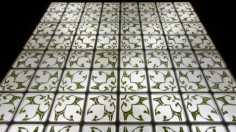Allison Kudla
Growth Pattern
source: revistaenieclarin
Growth Pattern, una serie de azulejos decorativos diseñados por la artista de Seattle Allison Kudla, que cambian de dibujo porque están hechos de hojas de tabaco cortadas dispuestas sobre una rejilla de placas de Petri cuadradas. Impregnadas de una solución que se comporta como una hormona, las hojas producen nuevo crecimiento.
“Muchísimas veces los dibujos decorativos se basan en sistemas botánicos”, dijo Kudla respecto del motivo simétrico (originalmente pensó en tejido de damasco). Las plantas sobreviven hasta seis meses si se controla con cuidado la solución y se reemplazan las placas que se contaminan con bacterias.
.
.
.
.
.
.
.
source: pinterest
A designer Allison Kudla colocou folhas de tabaco em uma grade de azulejos. A planta fica imersa em uma solução que funciona como hormônio e com isso estimula o seu crescimento. A duração deste processo é de seis meses
.
.
.
.
.
.
.
source: bioartjp
作品”Growth Pattern”は一定の形にカットされたタバコの葉が入っている64個のペトリ皿が並べられた2.5×2.5mの格子で構成されます。この作品は個々のパターンの形態を帯び、モチーフやインテリア・デザインの要素としての自然の歴史とデザインへの直接的なつながりを示します。
.
.
.
.
.
.
.
source: kristenbaumlier
Artist Allison Kudla works with digital media in order to create time-based botanical works. Some of her past works have included data generated real-time video/audio renderings, working with hybrid bio-mechanical systems, and using CNC technologies and plant tissue culturing.
In her project called Growth Pattern, Kudla explored how a living natural system can take on the form of a manufactured pattern.
To make the piece, tobacco leaves are die-cut into a symmetrical pattern and suspended in tiling square petri dishes that have the nutrients necessary to promote new leaf growth. The leaves are provided with the hormones that cause the cells to produce new leaf tissue, and the new leaves that grow extend the form of the traditional inspired botanical design.
When on display, the leaves change and change over time. Each tile is a self-contained ecosystem, and through they were decontaminated and sterilized, some contamination still occurs. In some tiles, the tissue dies. In others, parasites might grow faster in the leaves. In other tiles, new shoots begin to sprout from the original pattern.
.
.
.
.
.
.
.
source: allisonx
In this piece, a living natural system takes on the form of a manufactured pattern. Tobacco leaves are die-cut into a bilaterally symmetrical pattern and suspended in tiling square petri dishes that contain the nutrients necessary to promote new leaf growth.
Plant cells are totipotent. This means that, depending on the ratio of auxins to cytokinins, the cells have the capacity to differentiate into any organ in the plant. Here the cultured leaves are provided with the hormones that cause the cells to produce new leaf tissue. The newly growing leaves are extending the form of the traditionally inspired botanical motif. Due to the repetition of the pattern, the occupants to the space witness morphological changes in the tiles over the duration of the exhibit.
Since the tiles are self-contained ecosystems, several precautions were taken to make sure that, when the leaves were placed into the tiles, they were thoroughly decontaminated and sterilized. However, as with any experiment, it is possible for contamination to occur. In some, the tissue dies; in others, parasites take over and grow faster than the new leaves. In some tiles, aseptic conditions are achieved and new shoots begin to sprout from the original pattern.
.
.
.
.
.
.
.
source: folhauol
Para compartilhar esse conteúdo, por favor utilize o link http://www1.folha.uol.com.br/ilustrada/2013/01/1221511-designers-de-nova-york-fazem-casas-e-pontes-com-arvores-vivas.shtml ou as ferramentas oferecidas na página. Textos, fotos, artes e vídeos da Folha estão protegidos pela legislação brasileira sobre direito autoral. Não reproduza o conteúdo do jornal em qualquer meio de comunicação, eletrônico ou impresso, sem autorização da Folhapress (pesquisa@folhapress.com.br). As regras têm como objetivo proteger o investimento que a Folha faz na qualidade de seu jornalismo. Se precisa copiar trecho de texto da Folha para uso privado, por favor logue-se como assinante ou cadastrado.
.
.
.
.
.
.
.
source: z33be
Allison Kudla (1980) is een Amerikaanse new-media kunstenares met een sterke interesse in kunst en technologie en de relatie tussen de mens en zijn omgeving. Pas recent zette zij haar eerste stappen op internationaal vlak met een tentoonstellingenreeks gericht op kunst en technologie. Kudla gebruikt digitale media om omgevingen die constant veranderen te behouden en te ontdekken. Ze gebruikt technologie in haar werk om meer te weten te komen over het systeem waarin zij zelf bestaat.
Kudla’s werk ‘Growth Pattern’ is te zien in de tentoonstelling Alter Nature: We Can (21.11.2010-13.03.2011). In dit werk zien we 64 petrischaaltjes waarin versneden tabaksplantjes liggen. De bladeren zijn zo versneden dat ze een complex patroon weergeven. Door voedingsstoffen aanwezig in de schaaltjes, groeien de bladeren ook verder, waardoor het patroon verderloopt. In dit geval heeft de manipulatie van natuurlijk materiaal opnieuw een zuiver esthetisch doeleinde.
.
.
.
.
.
.
.
source: siggraphorg
Allison Kudla is an American artist who is currently an Artist-in-Residence at the Srishti School of Art, Design and Technology in Bangalore, India. She holds a BFA from the School of the Art Institute of Chicago, 2002. She is also a Doctoral Candidate at the University of Washington’s Center for Digital Arts and Experimental Media (DXARTS). In her most recent projects, she has been exploring the combination of patterns, fabrication technologies and plant tissue culturing to make living installations. Her work The Search for Luminosity was published in “Art + Science Now” by Stephen Wilson. Most recently, she received an Honorary Mention in Hybrid Arts at Ars Electronica 2010 for her work capacity for (urban eden, human error). The same work also received an Honorary Mention in the Vida Competition for Art and Artificial Life. Her work Growth Pattern was included in the group shows ”Alter Nature: We Can” at Z33 in Belgium and “When Process Becomes Paradigm” at Laboral Centro de Arte y Creacion Industrial in Spain. She is showing at Kapelica Gallery in Slovenia in 2011, and actively shows her works at Gallery BMB in Mumbai, India.


